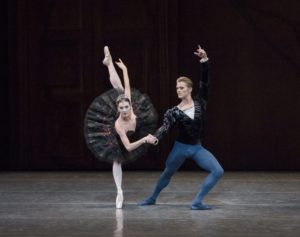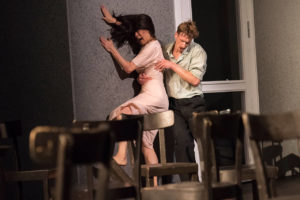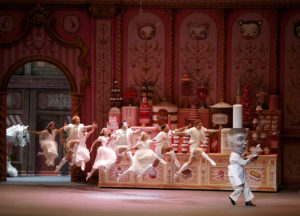2017 Year in Review – Dance
- By drediman
- December 25, 2017
- No Comments
2017 was a good year for dance in New York. It was a time in which both the old guard continued to set the standard and up-and-coming artists proved there mettle. Here are the highlights of my year of dance-going.
Swan Lake, again and again, gladly, in the right hands

Tiler Peck and Chase Finlay in New York City Ballet’s “Swan Lake” at the David H. Koch Theater.
In 2017, I saw Swan Lake not once, not twice … but five times. My goal: to compare and contrast, on successive nights, the qualities that activate this most mysterious of ballets, particularly with respect to the dual role of Odette/Odile (i.e., the “white swan” and the “black swan”, respectively). In her debut in the coveted role, City Ballet principal dancer Tiler Peck gave, in my mind, the performance of the year. Technically and dramatically, she astonished at every turn. Even at this early stage in her interpretation, I have no doubt Ms. Peck’s meticulously detailed yet gutsy take will prove legendary over time (particularly that Odile, my god!). I was also very impressed by Ashley Bouder’s nervy, emotionally-charged Odette/Odile. The performances of Ms. Bouder, also a principal at City Ballet, have always been marked with dynamism and technical prowess. But ever since coming back from giving birth to her daughter, she’s grown into an “important” ballerina. Her dancing is now more balanced and considered, not running on all cylinders all the time. This translates beautifully to Swan Lake, in which her portrayal has acquired nuance and depth that was previously – and noticeably – lacking. Over at American Ballet Theatre, Devon Teuscher, who was deservedly promoted to principal dancer this year, magnificently debuted her Odette/Odile to New York audiences this summer (she had previously danced it at the Kennedy Center in Washington, D.C.). Her exquisite classically-minded lines and demeanor and straightforward but potent delivery moved me deeply. I look forward to catching her rendition again this summer.
Pina Bausch and Mark Morris still set the gold standard in dance theater

Tanztheater Wuppertal Pina Bausch performs the classic “Café Müller” at the Brooklyn Academy of Music.
This year, I was lucky enough to catch a series of one-act masterpieces from the virtuosic Mark Morris and the late, great Pina Bausch. What’s clear from these viewings is that these two masters still continue to set the gold standard in dance theater. The Brooklyn Academy of Music played host to the return of Tanztheater Wuppertal Pina Bausch’s historic double bill of Café Müller and The Rite of Spring (this pairing had introduced Ms. Bausch to New York dance aficionados in the 1980s). Seeing these iconic works live for the first time gave me a thrill. Café Müller, in particular, struck me as an undisputed masterwork, revealing, in just a few gestural movements, the habits and tendencies that make us tragically human. Also, Bausch’s savage, riveting choreography for The Rite of Spring fit Stravinsky’s game-changing score, a piece that attracts choreographers like flies (mostly unsuccessfully), like a glove. Mark Morris Dance Group also resided at BAM, where it presented a double bill of gorgeously choreographed one-act operas, Britten’s Curlew River (based on a haunting Japanese noh drama) and Morris’s classic staging of Purcell’s Dido and Aeneas. Both exuded lightness, searching melancholy, and good humor as the respective plots required. Morris also debuted Layla and Majnun, a co-production with Silk Road Ensemble, to New York audiences as part of Lincoln Center’s White Light Festival. It was a revelation. With grace and simplicity, the piece movingly conjured the thematic timelessness of this Middle-Eastern iteration of Romeo and Juliet. This year, I also saw excellent casts take on dance theater pieces by Matthew Bourne (City Ballet principal Sara Mearns affectingly threw herself at The Red Shoes) and John Cranko (Diana Vishneva memorably, if melodramatically, bid farewell to ABT, co-starring with Marcelo Gomes in Onegin, before his fall from grace). However, neither could match Bausch and Morris’s deep understanding of the human condition; their works transcend both dance and theater, reaching beyond and within, incomparably.
Justin Peck and Alexei Ratmansky continue to justify the hype surrounding their rise

Alexei Ratmansky’s “Whipped Cream” for American Ballet Theatre at the Metropolitan Opera House.
For years now, the ballet world has touted a number of talented choreographers as the next big thing. I can spout out a list of names – Christopher Wheeldon, Benjamin Millepied, Wayne McGregor, Liam Scarlett, Justin Peck, Alexei Ratmansky, and on, and on. Of these, two have consistently met the hype with distinction and consistency, Justin Peck and Alexei Ratmansky. Mr. Peck, no longer the prodigious resident wunderkind choreographer at New York City Ballet, has graduated to the ranks of internationally-recognized “important” dance-makers. He’s the one young choreographers are now looking up to and dance companies are seeking out. And boy is he giving them a body of work to aspire to; The Year of the Rabbit, Paz de la Jolla, Everywhere We Go, and Rodeo are all definite keepers for lucky City Ballet. This year, he gave us an arresting collection of pas de deux entitled Pulcinella Variations, as well as the blockbuster The Times Are Racing, in which his unmatched skill at animating the corps de ballet was put to exciting use. I eagerly await the day Mr. Peck unveils his inevitable full-length ballet. Alexei Ratmansky, American Ballet Theatre’s current artist in residence, has been, for a number of years now, unmatched in the quantity and quality of his output. His poetic, sometimes offbeat – but always dramatically astute – sensibility has been a distinctive trait across his works. This year, for City Ballet’s ambitious Here/Now Festival, he presented the rich, pungent Odessa, which boldly pushed its dancers dangerously close to kitsch territory, only to ultimately register as seriously authentic. But without a doubt, the splashiest premiere of 2017 was Ratmansky’s delightful evening-length Nutcracker-esque confection Whipped Cream for American Ballet Theatre. Smartly constructed and extravagantly designed, the family-friendly production efficiently accelerated through its concise two acts, culminating in a giddy sugar high of a climax that left me deliriously on cloud nine. ABT has got a new classic on its hands.

 Copyright © 2024
Copyright © 2024
Leave a Reply